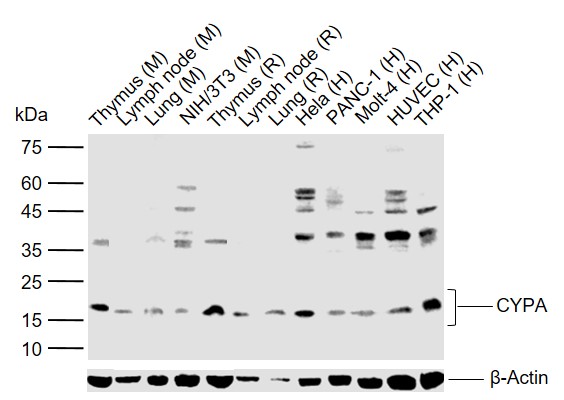Cyclophilin A antibody [N1C3]
GTX113520
ApplicationsWestern Blot, ImmunoHistoChemistry, ImmunoHistoChemistry Paraffin
Product group Antibodies
ReactivityHuman, Mouse, Rat
TargetPPIA
Overview
- SupplierGeneTex
- Product NameCyclophilin A antibody [N1C3]
- Delivery Days Customer9
- Application Supplier NoteWB: 1:500-1:3000. IHC-P: 1:100-1:1000. *Optimal dilutions/concentrations should be determined by the researcher.Not tested in other applications.
- ApplicationsWestern Blot, ImmunoHistoChemistry, ImmunoHistoChemistry Paraffin
- CertificationResearch Use Only
- ClonalityPolyclonal
- Concentration1 mg/ml
- ConjugateUnconjugated
- Gene ID5478
- Target namePPIA
- Target descriptionpeptidylprolyl isomerase A
- Target synonymsCYPA, CYPH, HEL-S-69p, peptidyl-prolyl cis-trans isomerase A, PPIase A, T cell cyclophilin, cyclosporin A-binding protein, epididymis secretory sperm binding protein Li 69p, peptidylprolyl isomerase A (cyclophilin A), rotamase A
- HostRabbit
- IsotypeIgG
- Protein IDP62937
- Protein NamePeptidyl-prolyl cis-trans isomerase A
- Scientific DescriptionThis gene encodes a member of the peptidyl-prolyl cis-trans isomerase (PPIase) family. PPIases catalyze the cis-trans isomerization of proline imidic peptide bonds in oligopeptides and accelerate the folding of proteins. The encoded protein is a cyclosporin binding-protein and may play a role in cyclosporin A-mediated immunosuppression. The protein can also interact with several HIV proteins, including p55 gag, Vpr, and capsid protein, and has been shown to be necessary for the formation of infectious HIV virions. Multiple pseudogenes that map to different chromosomes have been reported. [provided by RefSeq]
- ReactivityHuman, Mouse, Rat
- Storage Instruction-20°C or -80°C,2°C to 8°C
- UNSPSC12352203
References
- Chen YH, Lin WW, Liu CS, et al. H2O2 induces caveolin‑1 degradation and impaired mitochondrial function in E11 podocytes. Mol Med Rep. 2017,16(5):7841-7847. doi: 10.3892/mmr.2017.7497Read this paper






